Cetus constellation is located in the northern sky. Also known as the Whale, it is one of the largest constellations in the sky.
The constellation was named after Cetus, the sea monster from the Greek myth about Andromeda. In the myth, the princess was sacrificed to the monster as punishment for her mother Cassiopeia’s boastfulness. The constellation Cetus lies in the region of the sky called the Water, along with several other constellations with names evocative of water: Eridanus (the river), Aquarius (the water bearer), Pisces (the fish), etc. It was catalogued by the Greek astronomer Ptolemy in the 2nd century.
Cetus is home to the barred spiral galaxy Messier 77 and several well-known stars: Diphda (Beta Ceti), Menkar (Alpha Ceti), Tau Ceti and the famous variable star Mira (Omicron Ceti). It also hosts Earendel, the most distant star discovered to date.
Facts, location and map
Cetus is the fourth largest constellation in the sky, occupying an area of 1231 square degrees. It is one of the 15 equatorial constellations. It lies in the first quadrant of the southern hemisphere (SQ1) and can be seen at latitudes between +70° and -90°. The neighboring constellations are Aquarius, Aries, Eridanus, Fornax, Pisces, Sculptor, and Taurus.
The constellation name Cetus is pronounced /ˈsiːtəs/. In English, the constellation is known as the Sea Monster. The genitive form of Cetus, used in star names, is Ceti (pronunciation: /ˈsiːtaɪ). The three-letter abbreviation, adopted by the International Astronomical Union (IAU) in 1922, is Cet.
Cetus belongs to the Perseus family of constellations, along with Andromeda, Auriga, Cassiopeia, Cepheus, Lacerta, Pegasus, Perseus, and Triangulum.
Cetus has 14 stars with known planets and contains one Messier object, Messier 77 (M77, NGC 1068). The brightest star in the constellation is Diphda (Beta Ceti). There are three meteor showers associated with Cetus: the October Cetids, the Eta Cetids, and the Omicron Cetids.
The constellation contains eight formally named stars. The star names approved by the International Astronomical Union (IAU) are Axólotl, Baten Kaitos, Diphda, Kaffaljidhma, Menkar, Mira, Mpingo, and Felixvarela.
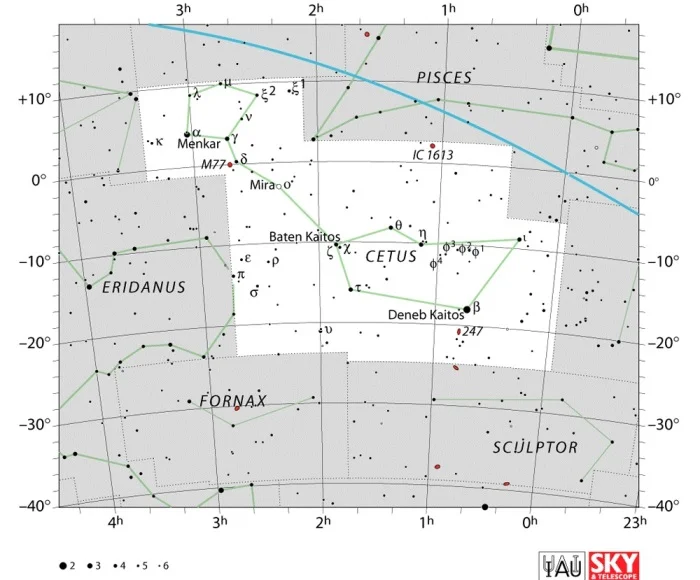
Cetus constellation map by IAU and Sky&Telescope magazine
Myth
Cetus represents the sea monster from the Greek myth of the princess Andromeda, whose boastful mother Cassiopeia angered the sea god Poseidon and the Nereids (sea nymphs) by claiming that she was more beautiful than any of them.
To appease the sea god and the nymphs, Cassiopeia and her husband, King Cepheus, had to sacrifice their young daughter to Cetus, a sea monster sent by Poseidon to punish the king and queen, or watch the monster ravage their land.
Andromeda was chained to a rock and left to the sea monster, but to her good fortune, the hero Perseus was passing by just as Cetus was about to devour her. Perseus rescued the princess and defeated Cetus. He and Andromeda were later married.
Cetus was commonly depicted by the Greeks as a hybrid creature. It had forefeet, huge jaws, and a scaly body like a giant sea serpent. Even though the constellation is also known as the Whale, the mythical creature in the depictions does not in fact look like a whale.
Cetus stars
Diphda (Deneb Kaitos) – β Ceti (Beta Ceti)
Beta Ceti is the brightest star in the constellation. It has an apparent magnitude of 2.04 and is approximately 96.3 light-years distant.
Beta Ceti is an orange giant belonging to the spectral type K0 III. It has left the main sequence stage of evolution and is on its way to becoming a red giant. With a surface temperature of 4,800 K, the star is slightly cooler than the Sun.
Beta Ceti is known by its traditional names, Deneb Kaitos and Diphda. Deneb Kaitos is derived from the Arabic phrase Al Dhanab al Ḳaiṭos al Janūbīyy, which means “the southern tail of Cetus,” and Diphda comes from aḍ-ḍafdaʿ aṯ-ṯānī, which is Arabic for “the second frog.” (The star Fomalhaut in Piscis Austrinus is usually referred to as the first frog.)
Menkar (Menkab) – α Ceti (Alpha Ceti)
Alpha Ceti is a very old red giant star, approximately 249 light years distant. The star will eventually eject its outer layers to form a planetary nebula, leaving a large white dwarf remnant. It has an apparent magnitude of 2.54.
The star’s traditional name, Menkar, comes from the Arabic word for “nostril.” Alpha Ceti is often used in works of science fiction, most notably in Star Trek: The Original Series. Alpha Ceti V was the planet on which Khan and his crew were exiled. In Star Trek: Enterprise, the same planet provided refuge to Humanity after the Xindi destroyed the Earth.
Mira – ο Ceti (Omicron Ceti)
Omicron Ceti, better known as Mira, is a binary star consisting of a red giant and a companion star. The system is approximately 420 light years distant.
Mira A, a red giant belonging to the spectral type M7 IIIe, is an oscillating variable star that serves as a prototype for an entire class of variables, the Mira variables. There are between 6,000 and 7,000 known stars belonging to this group. They are all red giants whose surfaces oscillate in such a way as to cause variations in brightness over periods ranging from 80 to more than 1,000 days.
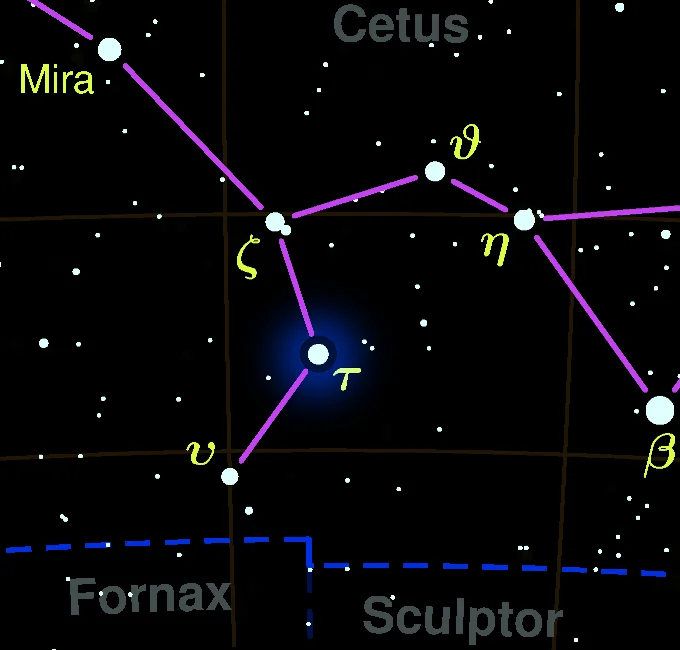
Location of Mira and Tau Ceti, star map by Torsten Bronger
Mira was the first non-supernova variable star discovered, with the possible exception of Algol in the constellation Perseus, which was confirmed as a variable only in 1667. Mira is believed to be about six billion years old.
The companion star, Mira B, is a high temperature white dwarf that is accreting mass from the red giant. The two form a symbiotic pair, the closest one of its kind to the Sun.
Mira is the brightest periodic variable star that cannot be seen by the unaided eye during a part of its cycle. It has a period of 332 days. Its variability was first documented by the German astronomer David Fabricius in 1596. Fabricius believed it was a nova until he saw the star again in 1609. Frisian astronomer Johannes Holwarda, who determined the star’s variation cycle, is usually credited for discovering its variability.
It was the Polish astronomer Johannes Hevelius who named the star Mira, meaning “wonderful” in Latin.
The star is shedding a trail of material from its outer envelope. NASA’s Galaxy Evolution Explorer space telescope has revealed a tail 13 light years in length, trailing after Mira.
τ Ceti (Tau Ceti)
Tau Ceti is a cool class G (G8.5) dwarf with an apparent magnitude of 3.5. It is one of the nearest stars to our solar system, lying only 11.9 light years away. It has a mass only about 78 percent that of the Sun and is one of the very few stars less massive than the Sun that are nevertheless visible to the unaided eye. It is a metal-deficient star with a high proper motion. Its luminosity is equal to only 55% of the Sun’s luminosity.
Tau Ceti and Epsilon Eridani in Eridanus constellation were the two nearby stars similar to the Sun that Cornell University astronomer Frank Drake picked for Project Ozma, a pioneering SETI experiment in 1960 aiming to discover intelligent signals from space. Needless to say, there weren’t any significant findings.
Earendel (WHL0137-LS)
Earendel (WHL0137-LS) is the most distant star discovered as of March 2022. It lies 28 billion light-years away. The star was detected through gravitational lensing caused by the massive galaxy cluster WHL0137-08 in the foreground. The cluster’s gravitational field magnified the star’s light between 1,000 and 40,000 times.
The properties of Earendel are uncertain, but NASA’s James Webb Space Telescope may allow a more detailed analysis of the star’s spectrum and provide astronomers with a better understanding of the star.
WHL0137-LS was nicknamed Earendel by the team of scientists that discovered it. The name is an Old English name for “morning star,” as well as a reference to the character Eärendil in J. R. R. Tolkien’s The Silmarillion (1977).
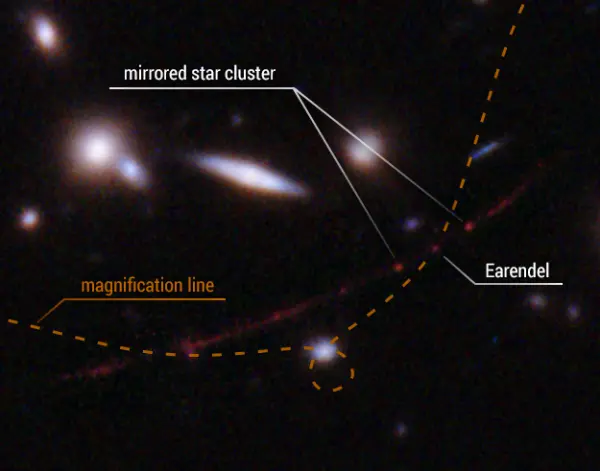
The Sunrise Arc galaxy with lensed star Earendel. Image: NASA, ESA, Brian Welch (JHU), Dan Coe (STScI). Image processing: NASA, ESA, Alyssa Pagan (STScI)
Deep sky objects in Cetus
Messier 77 (M77, NGC 1068)
Messier 77 is a barred spiral galaxy in Cetus, approximately 47 million light years distant and 170,000 light years in diameter. It has an apparent magnitude of 9.6. It is one of the largest galaxies listed in Messier’s catalogue.
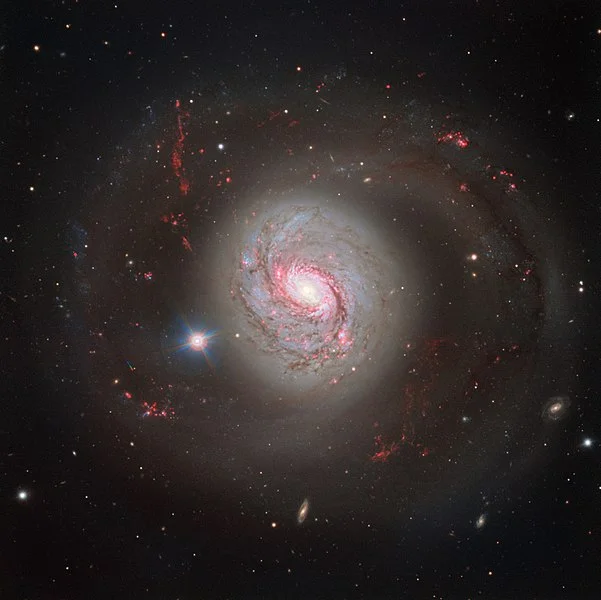
Messier 77 (Cetus A), image: ESO
Messier 77 was discovered by the French astronomer Pierre Méchain in 1780 and then catalogued by Charles Messier. Méchain originally described the object as a nebula, while Messier and William Herschel described it as a star cluster. The galaxy can be easily found 0.7 degrees east-southeast from Delta Ceti, a fourth magnitude star.
The galaxy has an Active Galactic Nucleus (AGN) which is blocked from view by intergalactic dust. The galaxy’s core is a strong radio source. Bernard Yarnton Mills was the first to discover this. He designated the object Cetus A.
NGC 1055
NGC 1055 lies only 0.5 degrees north-northeast of Messier 77. It is spiral galaxy, seen edge-on, approximately 52 million light years distant. It was discovered by the English astronomer William Herschel in 1783.
Next to Messier 77, NGC 1055 is a largest member of a galaxy group that also includes NGC 1073 and several smaller irregular galaxies. It has a diameter of about 115,800 light years. The galaxy is a known radio source.
NGC 1087
NGC 1087 is an intermediate spiral galaxy, approximately 80 million light years distant. It has a very small central bar and a number of irregular features in the disk of material that surrounds it. The galaxy’s nucleus is exceptionally small.
NGC 1087 is located close to NGC 1090, another barred spiral galaxy, but the two are not interacting.
NGC 1073
NGC 1073 is another galaxy in Cetus. It is believed to have an H II nucleus. It has an apparent magnitude of 11.5.
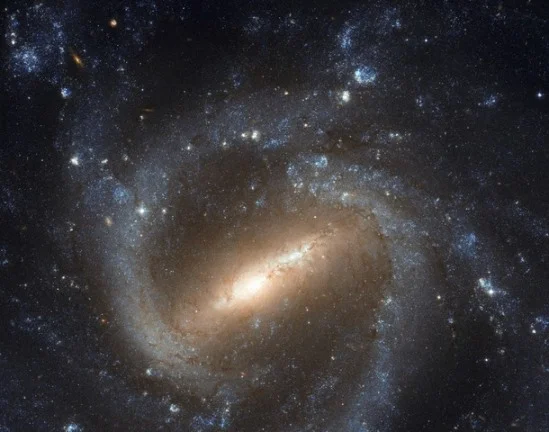
The NASA/ESA Hubble Space Telescope has taken a picture of the barred spiral galaxy NGC 1073, which is found in the constellation of Cetus (The Sea Monster). Our own galaxy, the Milky Way, is thought to be a similar barred spiral, and the study of galaxies such as NGC 1073 can help astronomers learn more about our celestial home. Image: NASA & ESA
NGC 45
NGC 45 is a barred spiral galaxy, about 32.6 million light years away in Cetus. It has an apparent magnitude of 10.4. The galaxy was discovered by the English astronomer John Herschel in 1835.
NGC 17
NGC 17 is a spiral galaxy in Cetus, approximately 250 million light years distant. It has an apparent magnitude of 15.3.
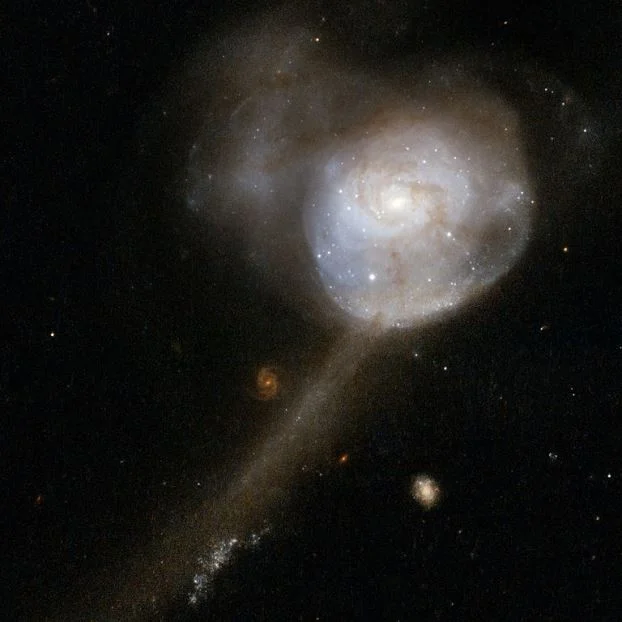
NGC 17, image: NASA, ESA, the Hubble Heritage (STScI/AURA)-ESA/Hubble Collaboration, and A. Evans (University of Virginia, Charlottesville/NRAO/Stony Brook University)
The galaxy is believed to have formed as a result of the merger of two disk galaxies. It shows recent starburst activity in the core regions and it is still gas rich.
NGC 47 (NGC 58)
NGC 47 is a barred spiral galaxy, approximately 236 million light years distant. It has an apparent magnitude of 13.5. It appears as a small spiral nebula with a bright core.
The galaxy was discovered by the German astronomer Ernst Wilhelm Leberecht Tempel in 1886. It is also known as NGC 58. (The American astronomer Lewis Swift observed the object later and was unaware that it had already been discovered by Tempel.)
NGC 1042
NGC 1042 is a spiral galaxy with an apparent magnitude of 14.0. It is located near another galaxy, NGC 1035, and the two are believed to be physically associated with each other because they have similar redshifts.
NGC 247
NGC 247 (Caldwell 62) is an intermediate spiral galaxy in Cetus, approximately 11.1 million light years distant. It is gravitationally bound to the Sculptor Galaxy (NGC 253) in Sculptor constellation, located in the centre of the Sculptor Group of galaxies, one of the nearest groups to the Milky Way Galaxy.
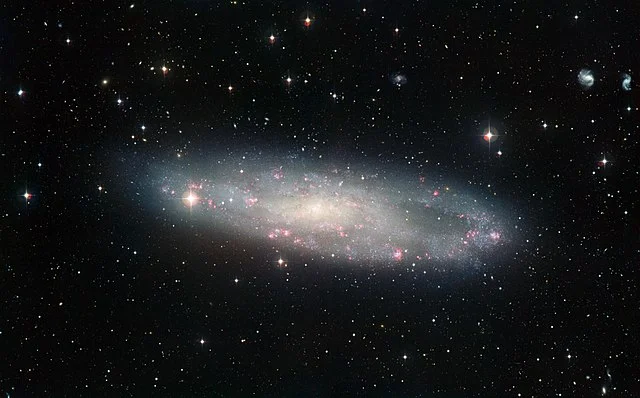
This picture of the spiral galaxy NGC 247 was taken using the Wide Field Imager (WFI) at ESO’s La Silla Observatory in Chile. NGC 247 is thought to lie about 11 million light-years away in the constellation of Cetus (The Whale). It is one of the closest galaxies to the Milky Way and a member of the Sculptor Group. Image: ESO